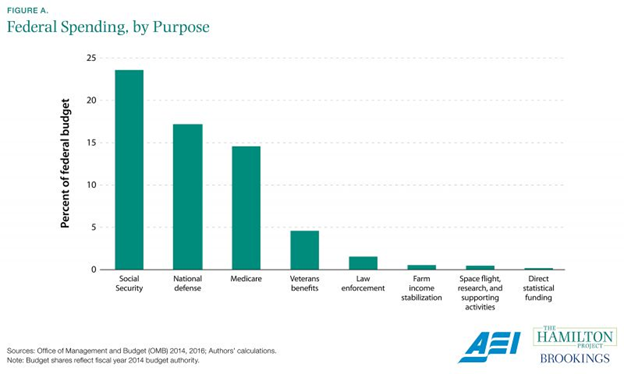But it would have disastrous effects on our ability to craft effective policy.
By Dwyer Gunn
(Photo: Peter Macdiarmid/Getty Images for Somerset House)
Last week, the Trump administration announced it would seek dramatic spending cuts across a number of agencies in order to pay for a $54 billion increase in defense spending. That will be tough to accomplish: The bulk of the federal government’s budget goes to Social Security, Medicare, and defense spending, all of which the president has vowed to leave untouched. The administration has specifically said it would target the Environmental Protection Agency and “foreign aid,” both of which constitute a very small proportion of the federal budget. But elsewhere in Washington, D.C., researchers are worried that another category of government spending is also vulnerable: spending on statistics and data.
Donald Trump’s hostility toward official economic data is especially well-known. His casual comments about the official unemployment rate being “phony” have pained economists for months, and researchers have worried that the administration might seek to either stop collecting necessary data altogether, or might direct agencies to skew data in a manner that supports certain policies or claims. Last month, the Wall Street Journalreported that the administration was already floating the idea of changing the way the government calculates trade deficits, with a revised methodology that would make trade gaps look bigger—a change that would presumably bolster support for Trump’s assertion that the country’s trade policies and agreements need to be re-negotiated or changed.
Here’s Clare Malone of FiveThirtyEight laying out the fears of many:
“Several of the [statistical] agencies have struggled with budgets since basically the early 2000s,” said Ken Poole, executive director of the Association of Public Data Users. Over the last few years, “all the agencies would have haircuts, and there’s a point at which you have no hair left, and you’re starting to cut into the bone.” He pointed to the Bureau of Labor Statistics and the Census Bureau, two of the largest producers of government data, as being particularly strapped.
Last week, the Hamilton Project at the Brookings Institution (often described as a center-left think tank) and the American Enterprise Institute (often described as a center-right think tank) held an event on the “vital role of government statistics.” The event was, in short, a full-throated, deeply passionate, bipartisan defense of the value and importance of government statistics.

(Chart: Brookings Institution)
As the chart to the left, from a report released in advance of the event, indicates, government spending on statistics, isn’t exactly blowing up the deficit. The government spends just 0.18 percent of its budget on “direct statistical funding.”
Here is just a small sampling of the different ways that individuals, businesses, and policymakers use government data:
- Local governments use data from the American Community Survey, an annual survey conducted by the Census Bureau, to make spending and policy decisions around things like transportation and economic development. Businessed use it to make decisions about inventory, advertising, and locations.
- The Federal Reserve uses government data on unemployment rates and consumer prices to determine if interest rates need to be adjusted.
- Politicians use data on labor force participation and earnings to evaluate the effectiveness of (and sometimes propose reforms to) programs like welfare, the Earned Income Tax Credit, and the Supplemental Nutrition Assistance Program.
- Researchers have used data from the Social Security Office of the Actuary to examine the large increase in the number of Americans receiving Social Security disability benefits throughout the 1980s and ’90s.
- Individuals can rely on employment projection data from the Bureau of Labor Statistics to identify promising future career paths.
Presumably the Trump administration will want to know if its economic policies actually are delivering higher wages and greater labor force participation. Without accurate government statistics, politicians, business owners, and individuals alike will be flying blind.





